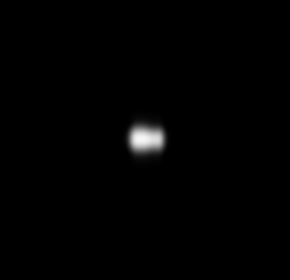Cupid (moon)
 | |
| Discovery | |
|---|---|
| Discovered by | Mark R. Showalter and Jack J. Lissauer |
| Discovery date | August 25, 2003 |
| Designations | |
Designation | Uranus XXVII |
| Pronunciation | /ˈkjuːpɪd/ |
| Adjectives | Cupidian /kjuːˈpɪdiən/[1] |
| Orbital characteristics | |
| 74,392 km | |
| Eccentricity | 0.0013 |
| 0.618 d | |
| Inclination | 0.1° (to Uranus' equator) |
| Satellite of | Uranus |
| Physical characteristics | |
| ~9 km[2] | |
| ~1,000 km² | |
| Volume | ~3,000 km³ |
| Mass | ~3.8×1015 kg |
Mean density | ~1.3 g/cm³ |
| ~0.0031 m/s² | |
| ~0.0076 km/s | |
| synchronous | |
| 0 | |
| Albedo | 0.07 (assumed) |
| Temperature | ~64 K |
Cupid is an inner satellite of Uranus. It was discovered by Mark R. Showalter and Jack J. Lissauer in 2003 using the Hubble Space Telescope.[3] It was named after a character in William Shakespeare's play Timon of Athens.[4]
It is the smallest of inner Uranian satellites, crudely estimated to be only about 18 km in diameter. This and the dark surface made it too dim to be detected by the Voyager 2 cameras during its Uranus flyby in 1986.
The orbit of Cupid differs only by 863 km from the orbit of the larger moon Belinda. Unlike Mab and Perdita, Uranian satellites also discovered in 2003, it does not seem to be perturbed.[2]
Following its discovery, Cupid was given the temporary designation S/2003 U 2.[3] It is also designated Uranus XXVII.[4]
It should not be confused with the asteroid 763 Cupido.
References
- ^ Tanner & Barnet (1995) Comedies
- ^ a b
Showalter, Mark R.; Lissauer, Jack J. (2006-02-17). "The Second Ring-Moon System of Uranus: Discovery and Dynamics". Science. 311 (5763): 973–977. Bibcode:2006Sci...311..973S. doi:10.1126/science.1122882. PMID 16373533.
{{cite journal}}: Invalid|ref=harv(help) - ^ a b Showalter, Mark R.; Lissauer, Jack J. (September 25, 2003). "S/2003 U 1 and S/2003 U 2". IAU Circular. 8209. ISSN 0081-0304. Retrieved 2011-11-02.
- ^ a b "Planet and Satellite Names and Discoverers". Gazetteer of Planetary Nomenclature. USGS Astrogeology. July 21, 2006. Retrieved 2006-08-05.
External links
- Hubble Uncovers Smallest Moons Yet Seen Around Uranus – Hubble Space Telescope news release (25 September 2003)


